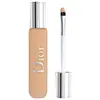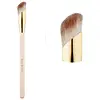Dior Backstage Face & Body Flash Perfector Concealer Versus Rare Beauty Liquid Touch Concealer Brush
What's inside
What's inside
 Key Ingredients
Key Ingredients

No key ingredients
 Benefits
Benefits

No benefits
 Concerns
Concerns

No concerns
 Ingredients Side-by-side
Ingredients Side-by-side

Water
Skin ConditioningPhenyl Trimethicone
Skin ConditioningIsododecane
EmollientDimethicone
EmollientMethyl Trimethicone
Skin ConditioningGlycerin
HumectantMica
Cosmetic ColorantAcrylates/Dimethicone Copolymer
Skin ConditioningCetyl PEG/PPG-10/1 Dimethicone
EmulsifyingPEG-9 Polydimethylsiloxyethyl Dimethicone
EmulsifyingButylene Glycol
HumectantTrimethylsiloxysilicate
EmollientTrimethyl Pentaphenyl Trisiloxane
EmollientSodium Myristoyl Glutamate
CleansingDisteardimonium Hectorite
StabilisingPolysilicone-11
Synthetic Fluorphlogopite
Caprylyl Glycol
EmollientButyrospermum Parkii Butter
Skin ConditioningGlyceryl Undecyl Dimethicone
Propylene Carbonate
SolventLecithin
EmollientSodium Benzoate
MaskingAluminum Hydroxide
EmollientHexadecene
SolventCaffeine
Skin ConditioningHydroxyacetophenone
AntioxidantParfum
MaskingAscorbyl Glucoside
AntioxidantTocopherol
AntioxidantTin Oxide
AbrasiveCitric Acid
BufferingPentaerythrityl Tetra-Di-T-Butyl Hydroxyhydrocinnamate
AntioxidantCI 77891
Cosmetic ColorantCI 77491
Cosmetic ColorantCI 77492
Cosmetic ColorantCI 77499
Cosmetic ColorantWater, Phenyl Trimethicone, Isododecane, Dimethicone, Methyl Trimethicone, Glycerin, Mica, Acrylates/Dimethicone Copolymer, Cetyl PEG/PPG-10/1 Dimethicone, PEG-9 Polydimethylsiloxyethyl Dimethicone, Butylene Glycol, Trimethylsiloxysilicate, Trimethyl Pentaphenyl Trisiloxane, Sodium Myristoyl Glutamate, Disteardimonium Hectorite, Polysilicone-11, Synthetic Fluorphlogopite, Caprylyl Glycol, Butyrospermum Parkii Butter, Glyceryl Undecyl Dimethicone, Propylene Carbonate, Lecithin, Sodium Benzoate, Aluminum Hydroxide, Hexadecene, Caffeine, Hydroxyacetophenone, Parfum, Ascorbyl Glucoside, Tocopherol, Tin Oxide, Citric Acid, Pentaerythrityl Tetra-Di-T-Butyl Hydroxyhydrocinnamate, CI 77891, CI 77491, CI 77492, CI 77499